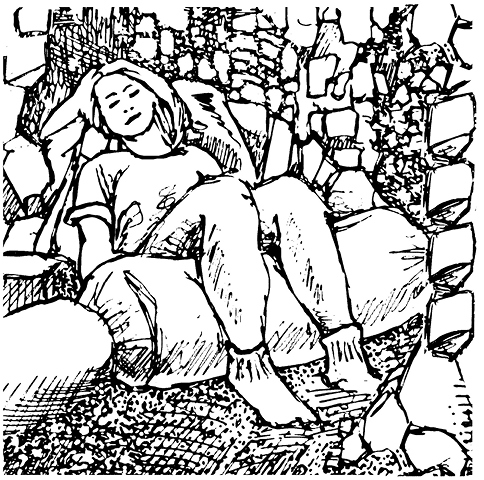Relax and Rejuvenate
with Himalayan Salt
by Kerri Connor

Himalayan salt is not the same as your ordinary table salt. For starters, it’s pink. It’s also a far healthier alternative and comes with many great benefits. Himalayan salt contains eighty-four trace minerals that may benefit the human body and treat conditions such as asthma, eczema, psoriasis, acne, allergies, sinusitis, and bronchitis and other respiratory illnesses, all while boosting the immune system. Himalayan salt has also been used for anti-inflammatory and antibacterial purposes. It is believed it may even help prevent the common cold and the flu. Studies have shown that the inhalation of Himalayan salt particles has even helped patients suffering from cystic fibrosis. On the emotional and mental side of things, Himalayan salt produces negative ions, which combat positive ions and can help reduce stress and fatigue, leaving the user feeling relaxed and refreshed
In some parts of the world, people have benefitted from salt cave therapy for centuries. In 1843, Polish doctor Felix Boczkowski noted that the miners at the salt mines in Wieliczka had excellent health and didn’t suffer from respiratory problems. Today the Wieliczka mine combines salt therapy with conventional medicine and is the largest underground treatment and rehabilitation center in the world.
Dr. Karl Herman Spannage noticed an improvement in his patients’ health after they hid in the Kluterthöhle karst cave in Germany to evade bombing. Those who had respiratory issues showed significant improvement. For decades, “salt therapy” took place underground in the actual salt mines and caves. This type of therapy is called speleotherapy.
It wasn’t until the late 1980s that a room was built for the purpose of salt therapy. This first man-made “salt cave” opened in Russia in 1987. Therapy in these above-ground, man-made caves (also known as halochambers) is called halotherapy.
These man-made caves are generally set up in a similar fashion. A large room is modeled to look like the inside of a cave. Some may put in fake stalagmites and stalactites, or perhaps a ceiling made to look like you are gazing up into a night time sky complete with stars (fiber-optic lighting). Half of the cave wall is generally Himalayan salt blocks, and then another material is used to create the cave the rest of the way up. Some of the blocks may have lighting behind them. This lighting serves two purposes. The first of course is to provide light that helps create a stress-free, peaceful environment. The second is to warm the salt to help produce negative ions. The cave is generally equipped with zero gravity chairs, blankets, additional salt lamps, and possibly headphones. Music lulls clients into a relaxed, meditative state.
One of the most important elements of the cave is the floor. The floor is covered in salt, generally a fine to medium-course grind, and is several inches deep. Many businesses require the removal of shoes and give you clean, white cotton socks to wear while in the cave room. This helps keep the salt floor clean, and as people walk through the salt, they kick the salt particles into the air. Pathogens such as bacteria and allergens are killed off by the salt, keeping it a clean environment. The salt molecules are made of a positive sodium ion and a negative chloride ion. When you breathe in the salt air, the molecules break down in the lungs and release the negative ions. These ions help clear up airways and clear mucus. People with a sodium chloride deficiency in their airway are able to correct it with this type of therapy. The salty air also works on the outside of the body to help clear up even chronic skin conditions.

While the popularity of salt caves is growing, they are still few and far between and generally only exist in large cities, making it difficult for people to try out this type of therapy. Large salt caves are also expensive to build, considering they require literally tons of salt, design, construction, and upkeep. For ultimate benefits, man-made salts caves need to be climate controlled. Spas add to the experience by creating a relaxing atmosphere, with lights and sound systems as well. All these components add considerably to the cost of building a large-scale, multiperson salt cave, which can easily cost several hundred thousand dollars by the final price tag. Because the cost to build is so high, sessions are also generally expensive as well. Sessions usually last forty-five to sixty minutes and range in price from twenty to fifty dollars, depending on location.
Himalayan Salt Therapy at Home
There are some less expensive, alternative ways to bring Himalayan salt and its benefits into your life.
If you have the money and space is not a limiting factor, you can always build your own smaller-sized, personal cave. This is obviously not an option for everyone and could easily total in the thousands of dollars, depending on how elaborate you go. However, if you have the funds and space, it could pay for itself with use by yourself, family, and friends.
A recent option on the market is found in the infrared sauna business. Some companies are now including blocks of Himalayan salt with their sauna kits. These kits run from about $1,250 to $3,500, depending on the size of the sauna. While this will provide some of the benefits derived from salt caves, it doesn’t give you the opportunity to kick up salt particles into the air to inhale, unless you add your own to the sauna floor.
Both of these alternatives, however, still require funds in the thousands and the dedicated space for a full-time salt cave or sauna. You can create a similar atmosphere right in your own bathtub for a fraction of the cost, though it will require setup and takedown time to use. You can start with the very basics and add to your collection as funds allow.
For starters you will need to find a bulk supplier of Himalayan salt. There are many online, and prices vary greatly. For this purpose you do not need food-grade salt. You will want a medium- to heavy-course grind. If you can only afford to buy ten pounds in bulk, start with that and add to it later on. If you can purchase twenty-five to fifty pounds, that would be ideal. Be sure to look for a company that offers free shipping. You will need five-gallon buckets with tight-fitting lids. (You may be able to get free ones from your local bakery—frosting comes in them.) This is where you will store your salt when it is not in use.
You will also want a queen-size sheet or comforter. (Do not use a knit blanket.) A comforter will hold its shape and stand up better than a sheet. Use this to line the bathtub after thoroughly drying the tub with a towel. If your tub is not enclosed, you can let the lining hang over the side to keep it from collapsing and falling in. If your tub and shower are combined, make sure your shower curtain is hanging the outside the tub so you be able to sit on the side of the tub with the curtain behind you. Standing inside the tub with clean white cotton socks on, close the shower curtain (or door) all the way and slowly start pouring the salt all over the bottom of the comforter or sheet lining the tub. As you pour, salt particles will float up into the air, and the shower curtain will help keep them confined to your area. Pour the salt slowly and evenly. After it’s poured in, take a seat on the side of the tub, or use a pillow to sit on top of the salt, and relax. You can add music, actual salt lamps, and even a salt inhaler, if you feel you need more or to create a more relaxing environment.
Spend an hour or so relaxing. You can spend as much time as you want, but since the preparation and cleanup are time consuming, make sure you have enough time to make it worth the effort. When you are done, scoop the salt back into the bucket and store it in a cool, dry area. Be sure to wash your comforter or sheet, and, if you can, store it in a plastic bag for later use. If possible, have one dedicated just to this use.
If this is too much for you as well, you can start with simple salt lamps. These also vary greatly in price, from five dollars for tealight holders to more than a hundred for heavy-duty lamps. There are many different styles available, from natural-looking rocks to specially cut designs, such as pyramids, cubes, spheres, yin and yang symbols, and even flowers. Bowls cut from the salt and filled with salt chunks or wire baskets filled with salt chunks are also options. I have found many great ones with free shipping through eBay. If ordering online, take the time to find ones that come with free shipping, as the salt is often several pounds and shipping costs can add up quickly. It’s ideal to keep a lamp or two in your bedroom and another one in rooms with electronics such as computers or TVs. These electronics give off a lot of positive ions, and the salt lamps help neutralize these with their own negative ions. If possible, keep computers, tablets, cell phones, and TVs out of your bedroom. Leave this room as a haven to relax, rest, and restore. While salt lamps give off negative ions, they don’t offer the benefits that come with inhalation of the actual salt particles. You can get these benefits by using a salt inhaler. The Himalayan salt crystals fit into filters on the inhalation device. As you inhale, moisture from the air absorbs the salt particles, and then they enter your respiratory system.

Alterative Home Options
There are other ways you can add Himalayan salt to your life. If you have a hot tub, you can convert from a chlorine or bromine system to a saltwater system instead. Using salt is all-natural with no harsh chemicals. All it requires is salt, baking soda, white vinegar, and a special saltwater chlorinator. Instructions and measurements are provided with the devices.
You can add Himalayan salt to your bathwater as well. When ground finely, it will dissolve quickly and soften the water, leaving skin smooth, soft, and refreshed. Pink Himalayan salt soap and deodorant are also available to fill your hygienic needs. In the kitchen, of course, you can replace plain table salt with Himalayan salt, and you will be able to taste the difference with this alternative.
Finally, you can make a Himalayan salt sole to use each day as a natural way to detox, boost immunity, balance hormones, improve thyroid function, and more. To make a salt sole, use a glass jar with a plastic lid (an old mayonnaise jar is ideal). Fill the jar about one-fourth of the way with salt and top off with filtered water. Shake the jar. If all of the salt dissolves, add more. You want to fully saturate the water with salt. Once you have leftover salt at the bottom, it is ready. To use, each morning take one teaspoon of sole in a glass of room temperature water. Make sure to never use metal with the sole for long periods of time because it can oxidize.
Himalayan salt is a pure, natural resource that can help improve both physical and emotional health. It is truly a gift from Mother Earth.